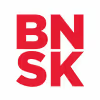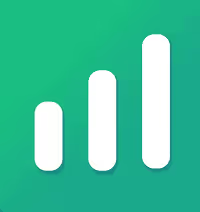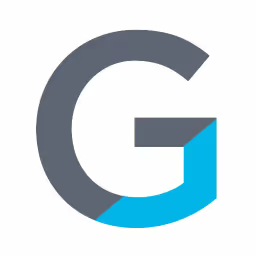Yesware Alternatives
Compare 10 Yesware alternatives. This guide analyzes features, pricing, and use cases to help you choose the right sales engagement tool.

Yesware is a popular tool for many sales teams, and for good reason. It performs well for its core functions, like sales engagement and email tracking, helping users manage outreach and get valuable insights into how recipients interact with their messages.
However, some users report occasional technical issues, integration problems, or slow support. This can lead teams to look for alternatives. We've analyzed the best alternatives based on G2 reviews, comparing their pros and cons to Yesware to help you shortlist options. Let's get started.
11x: Digital Workers for Sales
If you are exploring options beyond traditional sales engagement tools, consider 11x. It provides digital workers to handle sales tasks. You can learn more about how this approach might fit your team's goals.
11x is a GTM platform where our AI agents manage the sales process. Alice finds prospects, runs outreach via email and LinkedIn, and maintains your CRM.
Julian qualifies inbound leads and books meetings. We consolidate functions like data enrichment, outreach, and email warmup, removing the need for separate point solutions.
Yesware Alternatives
The following section reviews several Yesware alternatives. We break down each tool's pricing, main features, and its advantages and drawbacks when compared to Yesware to help you evaluate your options.
1) Outreach
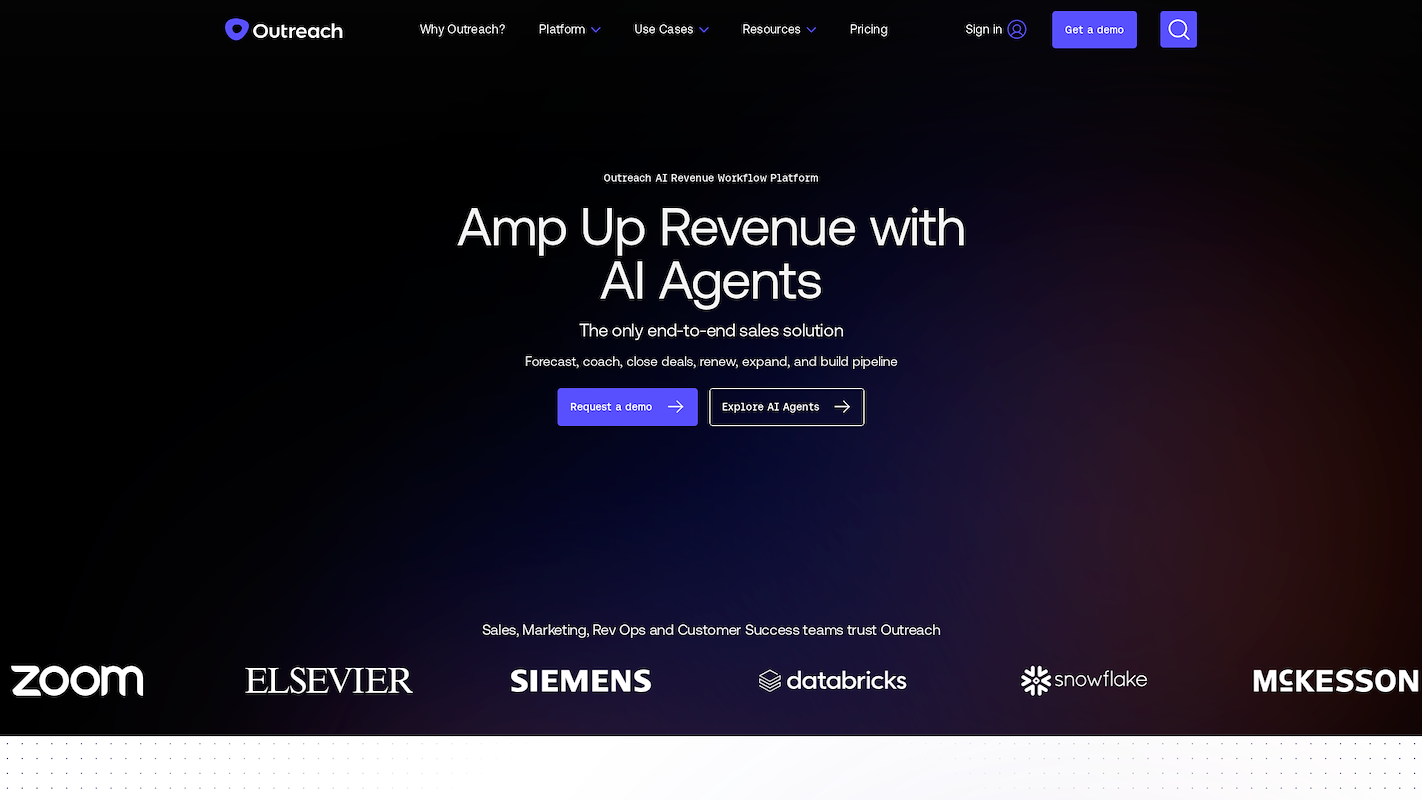
Outreach is a revenue workflow platform that uses AI. It functions as an end-to-end sales execution solution with generative-AI agents and data-driven workflows. The platform helps teams forecast revenue, manage deals, and organize their books of business to build a pipeline.
It also supports account retention and expansion through its workflows. The company emphasizes security, privacy, and governance for customer data.
Outreach's Main Features
- Deploys AI agents to manage tasks across the revenue cycle, including prospecting, engagement, forecasting, and deal management.
- Provides pipeline and forecast analytics to predict revenue outcomes, identify pipeline gaps, and run scenario forecasts.
- Uses an AI assistant, Kaia, for rep coaching, which generates meeting summaries, Q&A, and analytics with deep-linked call moments for managers.
- Analyzes buyer sentiment by detecting topics and emotional tone across meetings, calls, and emails to surface risks and opportunities.
Outreach's Advantages Compared to Yesware
Average Review score: 4.3/5 stars based on 3,479 G2 reviews.
- Outreach uses AI agents to manage tasks across the entire sales cycle, including deal management, which is a broader scope than Yesware's focus on email engagement.
- The platform includes revenue intelligence tools for pipeline and revenue forecasting, offering deeper analytics compared to the email interaction data provided by Yesware.
- Its AI assistant, Kaia, provides sales coaching by analyzing calls and generating summaries, a representative development feature that Yesware does not have.
- Sentiment analysis of buyer communications helps identify deal risks, offering insights beyond the standard engagement metrics that Yesware tracks.
- The tool unifies sales engagement, revenue intelligence, and revenue operations, which can reduce the need for separate tools that a Yesware setup might require.
Outreach's Disadvantages Compared to Yesware
- Outreach is a comprehensive platform, which can make it more complex and costly than Yesware. Teams that only need core email tracking and engagement features might find Yesware a more straightforward solution.
- Some users report integration and sync issues, particularly with certain CRMs. In comparison, Yesware often provides a more direct experience within specific email clients like Gmail and Outlook.
- The tool can sometimes experience slow loading times, according to user feedback. This may be a consideration for sales teams that prioritize speed in their daily workflow over a broad feature set.
Pricing and Cost-Effectiveness
Yesware offers clear pricing tiers at $15, $35, and $65 per user monthly. In contrast, Outreach does not publish its prices and provides custom enterprise quotes. Yesware is therefore more budget-friendly for teams with standard needs, while Outreach targets large organizations needing a tailored, all-in-one platform.
2) Salesloft
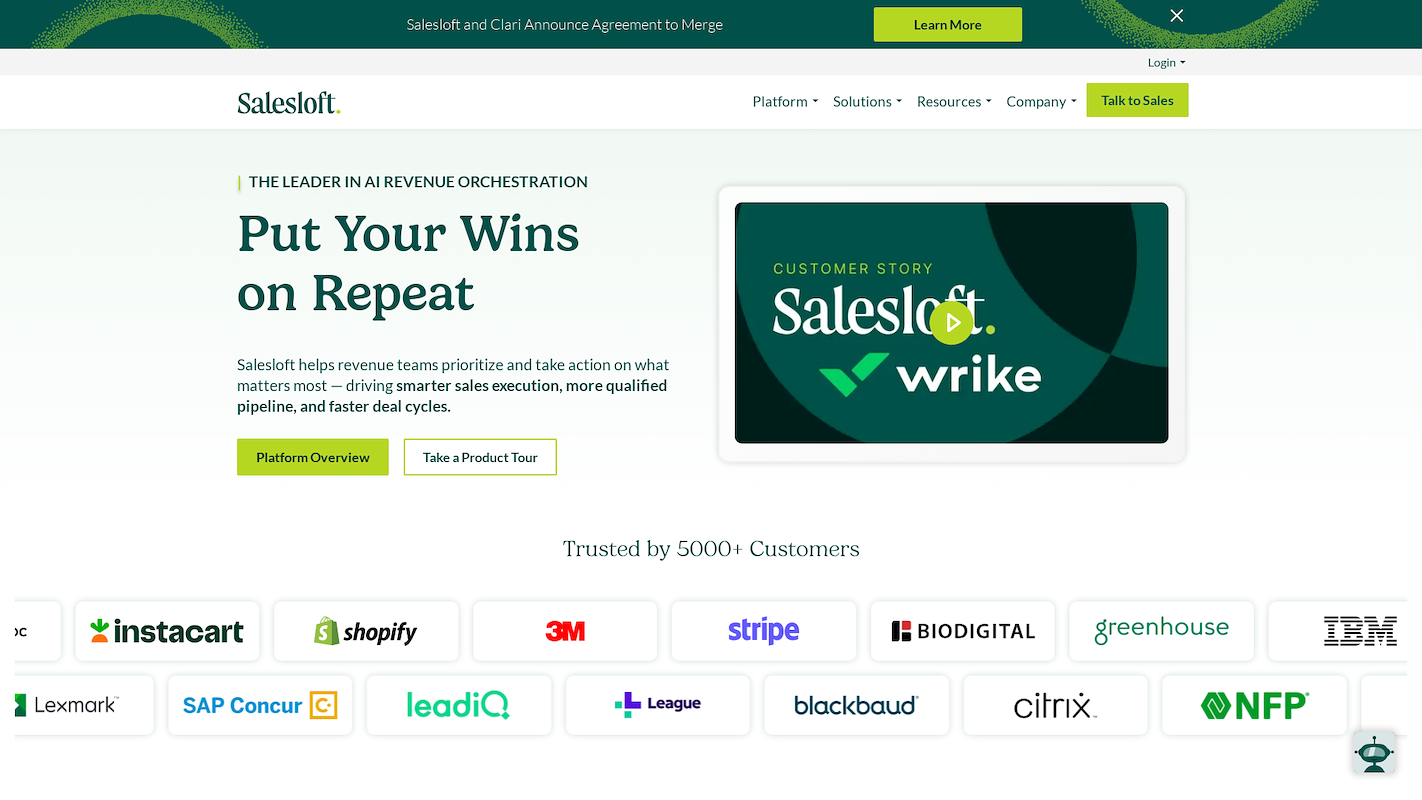
Salesloft is a Revenue Orchestration Platform that aligns sales engagement, AI insights, deal management, and forecasting in a single workflow. Its purpose-built AI agents surface buyer signals, prioritize actions, and automate tasks.
The platform helps teams build more qualified pipeline, shorten deal cycles, and forecast with confidence. It is used for team productivity and performance optimization.
Salesloft's Main Features
- Uses Rhythm AI to prioritize and recommend actions for sellers at specific moments.
- Engages website visitors with real-time, personalized conversations through its Drift AI chat agents.
- Provides conversation intelligence by analyzing recorded calls to generate insights for coaching and performance improvement.
- Offers a deal management module with AI insights into risk, next steps, and velocity to help manage the pipeline.
Salesloft's Advantages Compared to Yesware
Average Review score: 4.5/5 stars based on 4,145 G2 reviews.
- Salesloft uses its Rhythm AI to prioritize a seller's most important actions. This provides more direct guidance compared to Yesware's focus on managing email outreach.
- The platform includes conversation intelligence, which analyzes calls to find coaching moments. This is a representative development feature that Yesware does not have.
- It offers a deal management module that uses AI to show pipeline risks. This function supports the full deal cycle, while Yesware centers on top-of-funnel engagement.
- The tool combines sales engagement, forecasting, and conversation intelligence in one platform. This may reduce the need for separate tools that a team using only Yesware might need.
Salesloft's Disadvantages Compared to Yesware
- Salesloft is a comprehensive platform, which can make it more complex and costly for some teams. In contrast, Yesware offers a more direct experience with transparent pricing that may better suit teams with simpler needs.
- The tool's extensive capabilities can result in a steeper learning curve for new users. Yesware integrates directly into an email client, which some teams may find more straightforward for daily tasks.
- Some users report occasional integration or sync issues with Salesloft. Yesware often provides a more seamless experience because it operates directly inside email clients like Gmail and Outlook.
Pricing and Cost-Effectiveness
Yesware offers transparent pricing tiers at $15, $35, and $65 per user monthly. Salesloft does not publish its prices, so for the most accurate information, we recommend visiting Salesloft's official website.
3) Mixmax

Mixmax is a sales-engagement platform that operates inside Gmail and Outlook. It helps revenue teams build pipeline and manage deals directly from their inbox. The tool supports account executives, customer success managers, and sales development teams.
Its capabilities include multichannel outreach, calendar functions, and workflow automation. The platform also provides engagement signals to prioritize prospects and a Meeting Copilot for automatic meeting notes and summaries.
Mixmax's Main Features
- Includes a Meeting Copilot that automatically generates meeting summaries, drafts follow-up emails, and provides full transcripts.
- Uses an AI Engagement Score to prioritize prospects and provides real-time alerts on engagement activity.
- Automates workflows by updating CRM fields, auto-creating leads, and enabling internal collaboration through an Inbox Sidechat feature.
- Provides an AI Sequence Builder for multichannel campaigns and uses AI Smart Send to deliver emails at optimal times for engagement.
Mixmax's Advantages Compared to Yesware
Average Review score: 4.6/5 stars based on 1,433 G2 reviews.
- Mixmax includes a Meeting Copilot that automatically creates meeting summaries and drafts follow-up emails. This provides post-meeting support that is not a core feature of Yesware.
- The tool uses an AI Engagement Score to help teams prioritize prospects based on their activity. This offers more direct guidance than Yesware's standard email engagement tracking.
- It allows users to add polls and surveys directly into emails for more interactive communication. In comparison, Yesware focuses on tracking opens and clicks.
- Mixmax provides an Inbox Sidechat feature for internal team collaboration directly within the email client, a communication tool not found in Yesware's feature set.
- The platform offers an AI Sequence Builder to create multichannel campaigns and uses AI Smart Send to deliver emails at optimal times, a more advanced scheduling feature than what Yesware provides.
Mixmax's Disadvantages Compared to Yesware
- Yesware's pricing is more accessible, with plans starting at $15 per user. In comparison, Mixmax's entry-level plan is higher, which might not be cost-effective for smaller teams who only require basic email tracking and template features.
- Mixmax includes many features like polls and side chat, which can create a steeper learning curve for some users. Yesware focuses on core email functions, offering a more straightforward experience that teams may find easier to adopt for daily tasks.
- Some users report that Mixmax can occasionally slow down their Gmail performance due to its extensive features. Yesware, with its more focused feature set, is often perceived as lighter and less likely to impact inbox speed.
Pricing and Cost-Effectiveness
Yesware's pricing is more granular, starting at $15 per user monthly for its Pro plan and going up to $65 for Enterprise. In contrast, Mixmax's plans begin at $49 for its Growth tier, making Yesware the more cost-effective choice for teams with basic needs or those wanting to scale features gradually. For the most accurate information, we recommend visiting Mixmax's official website.
4) Apollo.io
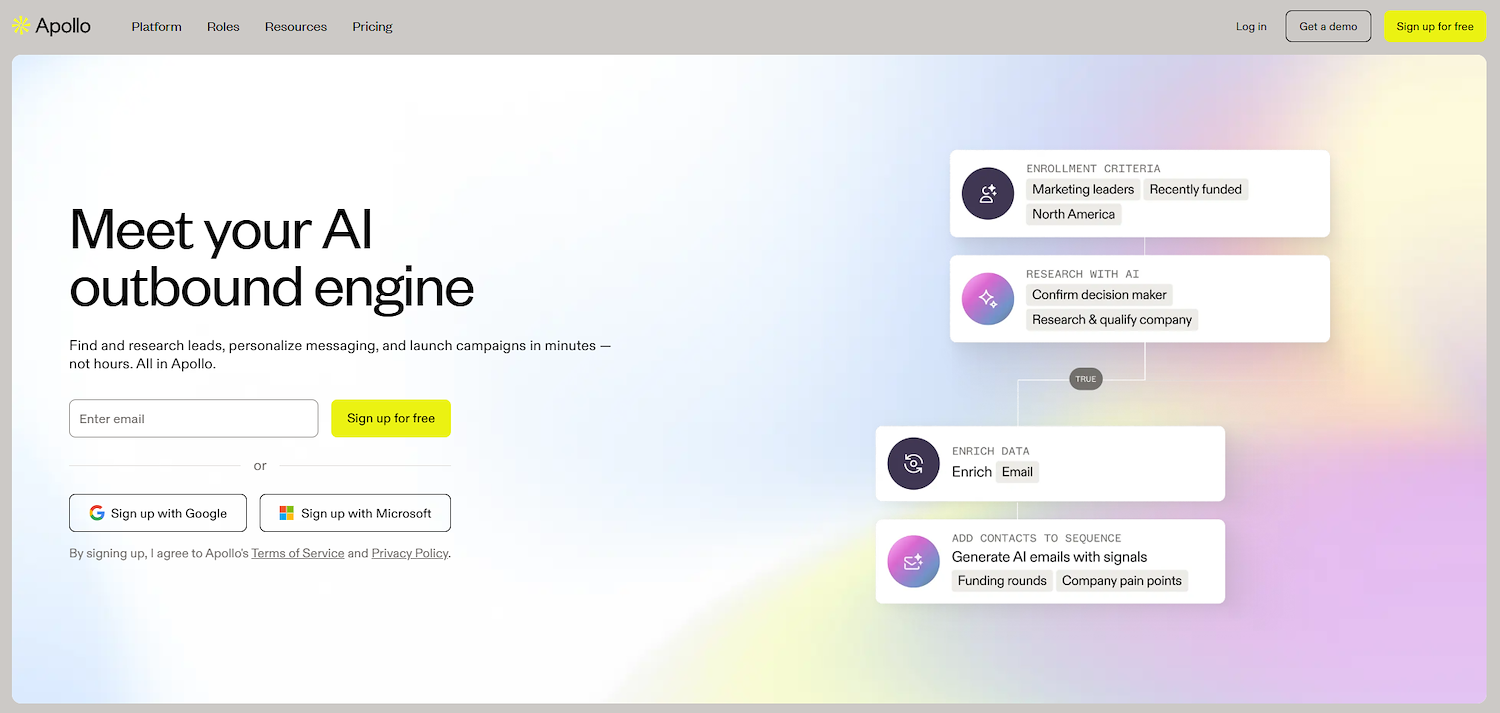
Apollo.io is a sales intelligence and engagement platform with a B2B contact database. It provides tools to find prospects, engage contacts, and automate workflows for sales and marketing teams. The platform supports the execution of go-to-market strategies.
Users can build lists, run outreach campaigns, and manage their sales pipeline. It combines data with workflow automation to support sales development and account management from a single interface.
Apollo.io's Main Features
- Includes a B2B contact database that allows users to find prospects and build targeted lists.
- Automates sales workflows, such as outreach campaigns, by combining its internal data with engagement tools.
- Provides tools to manage the sales pipeline and execute go-to-market strategies from a single interface.
Apollo.io's Advantages Compared to Yesware
Average Review score: 4.7/5 stars based on 8,904 G2 reviews.
- Apollo.io includes a B2B database with over 210 million contacts, which allows teams to find new prospects directly within the platform. This is different from Yesware, which primarily tracks engagement with existing contact lists.
- The platform provides lead enrichment and validation features. This helps maintain data accuracy in a CRM, whereas Yesware focuses more on tracking the interactions themselves.
- It combines sales intelligence with engagement tools in a single interface. This can reduce the need for separate prospecting and outreach tools that a team might use alongside Yesware.
- This tool offers buyer intent data to help users identify which accounts are actively researching solutions. This provides a different layer of insight compared to Yesware's email open and click tracking.
Apollo.io's Disadvantages Compared to Yesware
- Apollo.io is a comprehensive platform, which can be more complex than Yesware. Teams that only need core email tracking and templates might find Yesware's focused approach easier to adopt.
- The tool's extensive features can create a steeper learning curve for new users. In contrast, Yesware's direct integration within an email client often provides a more straightforward experience for daily tasks.
- While Apollo.io includes a large contact database, some users report that data can occasionally be inaccurate. This is different from Yesware, which works with a user's existing contact lists and focuses on engagement tracking.
Pricing and Cost-Effectiveness
Apollo.io has a free plan, and its paid tiers start at $49 per user, while Yesware's start at $15. The price difference is due to Apollo.io's B2B database, making Yesware more cost-effective for teams needing only email engagement. For detailed pricing, visit Apollo.io's official website.
5) Groove (formerly Groove.co)
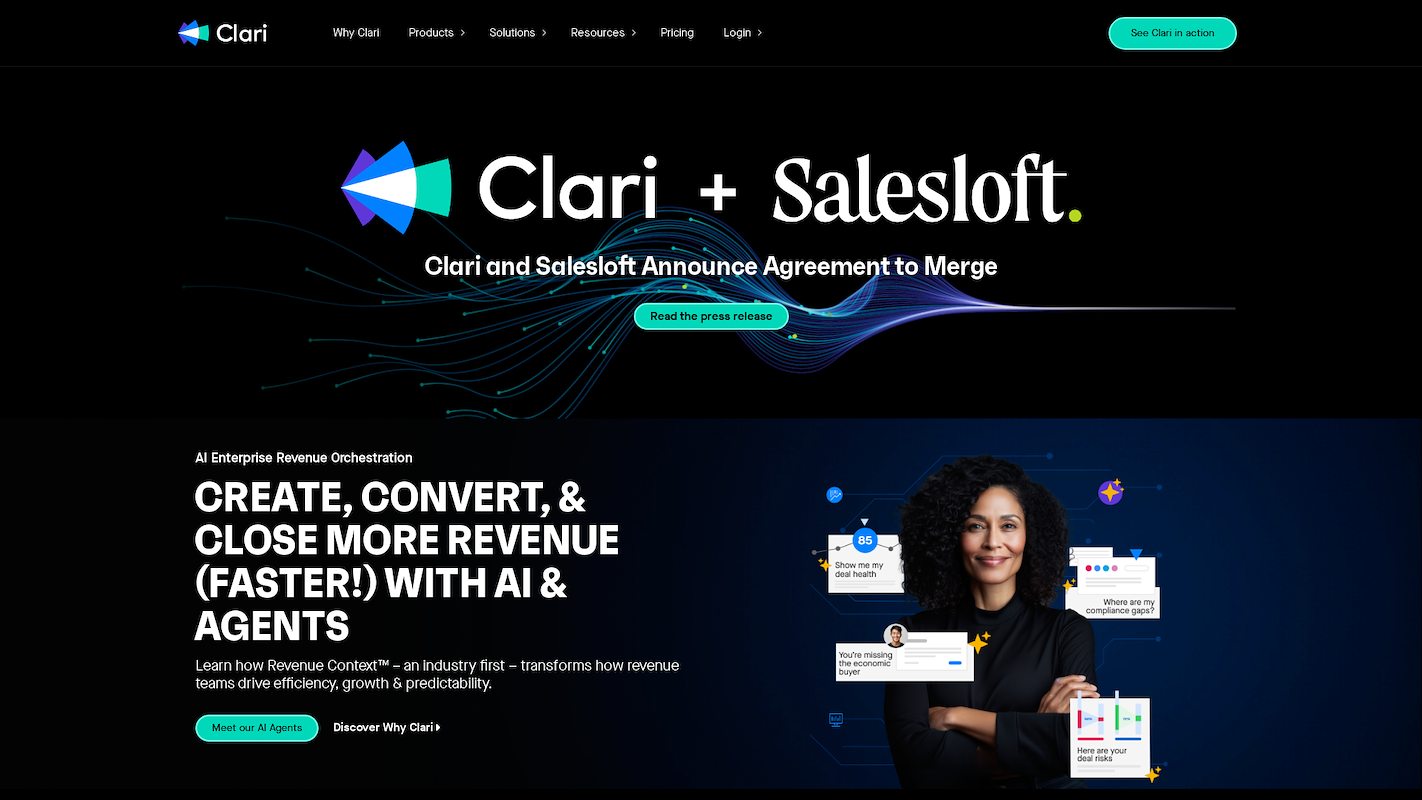
Groove (formerly Groove.co) is a sales engagement platform for revenue teams that use Salesforce. It helps users generate pipeline and win deals through multi-channel campaigns. The platform automates tasks like email outreach and call logs, and it provides a single data source for account and contact information.
Groove (formerly Groove.co)'s Main Features
- Offers native Salesforce integration, which ensures all sales engagement data is automatically captured in the CRM.
- Enables multi-channel campaigns, allowing users to orchestrate outreach across email, phone, and social platforms.
- Automates administrative tasks such as logging calls and emails in Salesforce to reduce manual data entry.
Groove's Advantages Compared to Yesware
Average Review score: 2.0/5 stars based on 1 G2 reviews.
- Groove includes Crowd Agent, a platform connecting companies with recruiters. This provides a tool for talent acquisition, a function outside the scope of Yesware's focus on sales email engagement.
- It offers Forkwell, an AI-driven skill database for engineers. This supports technical talent management, an area that Yesware's sales-oriented toolkit does not address.
- The platform is noted for its good visuals, which can offer a different user interface experience from the functional layout Yesware provides within an email client.
- Its customer support is described as fast. This can provide users with quick assistance, which is a different experience from the slower support some Yesware users report.
Groove’s Limitations Compared To Yesware
- Some users note Groove has limited reporting capabilities. This is different from Yesware, which provides detailed analytics on email opens, clicks, and recipient engagement to measure performance.
- Groove does not operate inside an email inbox for sales tasks. In comparison, Yesware integrates directly into Gmail and Outlook, allowing teams to track emails and use templates without leaving their inbox.
- The tool's features, like Crowd Agent and Forkwell, focus on HR and recruitment. This contrasts with Yesware, which is built specifically for sales teams to manage outreach and engagement.
Pricing and Cost-Effectiveness
Yesware provides transparent pricing at $15, $35, and $65 per user monthly. Groove does not publish its pricing, so for the most accurate information, we recommend visiting Groove's official website.
Explore Digital Workers With 11x
If your team seeks a different approach to sales tasks, consider 11x. The platform provides digital workers to manage prospecting, outreach, and CRM updates. This automates parts of the sales process and may fit your operational goals. You can learn more about this model on their website.
At 11x, we manage your sales playbook with AI. Alice finds prospects, enriches data, and handles outreach. Julian qualifies inbound leads and schedules meetings. Our platform consolidates your GTM stack, replacing separate tools for data, outreach, and email warmup.
Book a demo to see how it works.
6) Mailshake
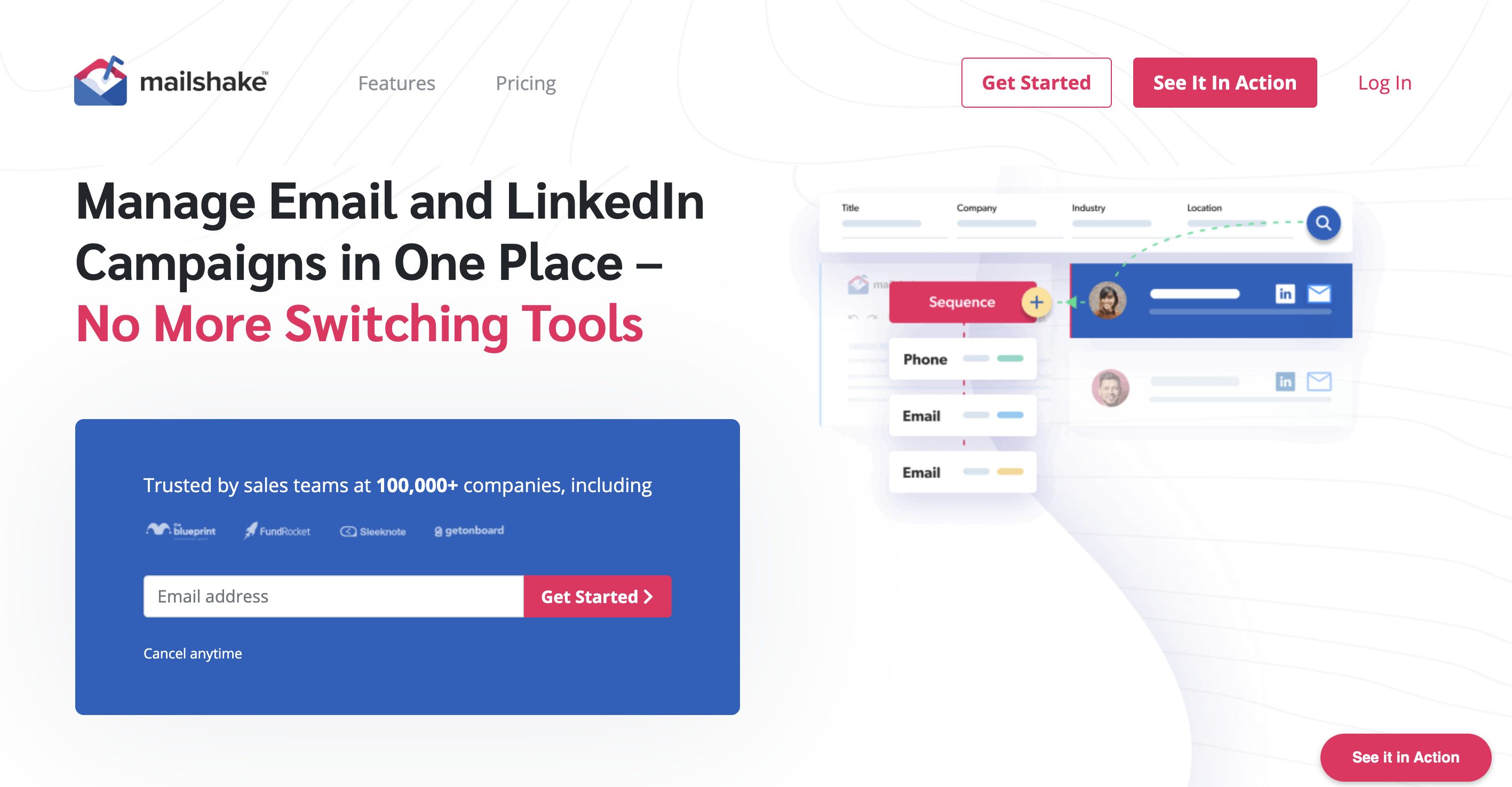
Mailshake is a sales engagement platform. Sales teams use it to create personalized outreach sequences through email, social platforms, and phone. The tool works with a user's Gsuite or Outlook account.
Common applications include sales, public relations, and content promotion. The platform also supports efforts to acquire links and generate new leads.
Mailshake's Main Features
- Includes a built-in database to search and purchase verified prospect email addresses by role, location, or company.
- Automates LinkedIn connection requests, profile views, and messages as part of multi-channel sequences.
- Uses an AI writer, SHAKEspeare, to auto-generate and spin copy, subject lines, and A/B test variants.
- Provides an email deliverability suite with a domain setup assistant, email warm-up, list cleaning, and a copy analyzer.
Mailshake's Advantages Compared to Yesware
Average Review score: 4.7/5 stars based on 326 G2 reviews.
- Mailshake includes an email deliverability suite with a domain setup assistant and email warm-up tools. This provides a more comprehensive solution for inbox placement compared to Yesware's focus on post-delivery engagement tracking.
- It uses an AI writer, SHAKEspeare, to generate and A/B test email copy. This offers automated content creation, while Yesware provides templates for users to manually populate and test.
- The platform provides a built-in database to find and purchase verified prospect emails. This is different from Yesware, which operates on a user's existing contact lists rather than providing a source for new ones.
- This tool automates LinkedIn tasks like connection requests and messages within its sequences. This expands outreach to social platforms, whereas Yesware's core functionality centers on email engagement.
Mailshake's Disadvantages Compared To Yesware
- Mailshake operates from a separate dashboard, while Yesware integrates directly into the user's inbox. This may require users to switch contexts, which is different from Yesware's in-inbox workflow.
- Yesware provides detailed, real-time analytics on how recipients interact with individual emails. Some users find Mailshake's reporting less granular, which can be a factor for teams that need deep engagement metrics.
- The platform's focus on automated sequences can feel rigid to some users who prefer more manual control. In comparison, Yesware's design allows for more flexible, one-off email tracking within the inbox.
Pricing and Cost-Effectiveness
Yesware offers plans at $15, $35, and $65 per user monthly. Mailshake's tiers are priced at $29, $59, and $99 per month, making Yesware the more budget-friendly option for core email engagement. Mailshake's higher cost covers additional features like a prospect database and deliverability tools.
7) GMass
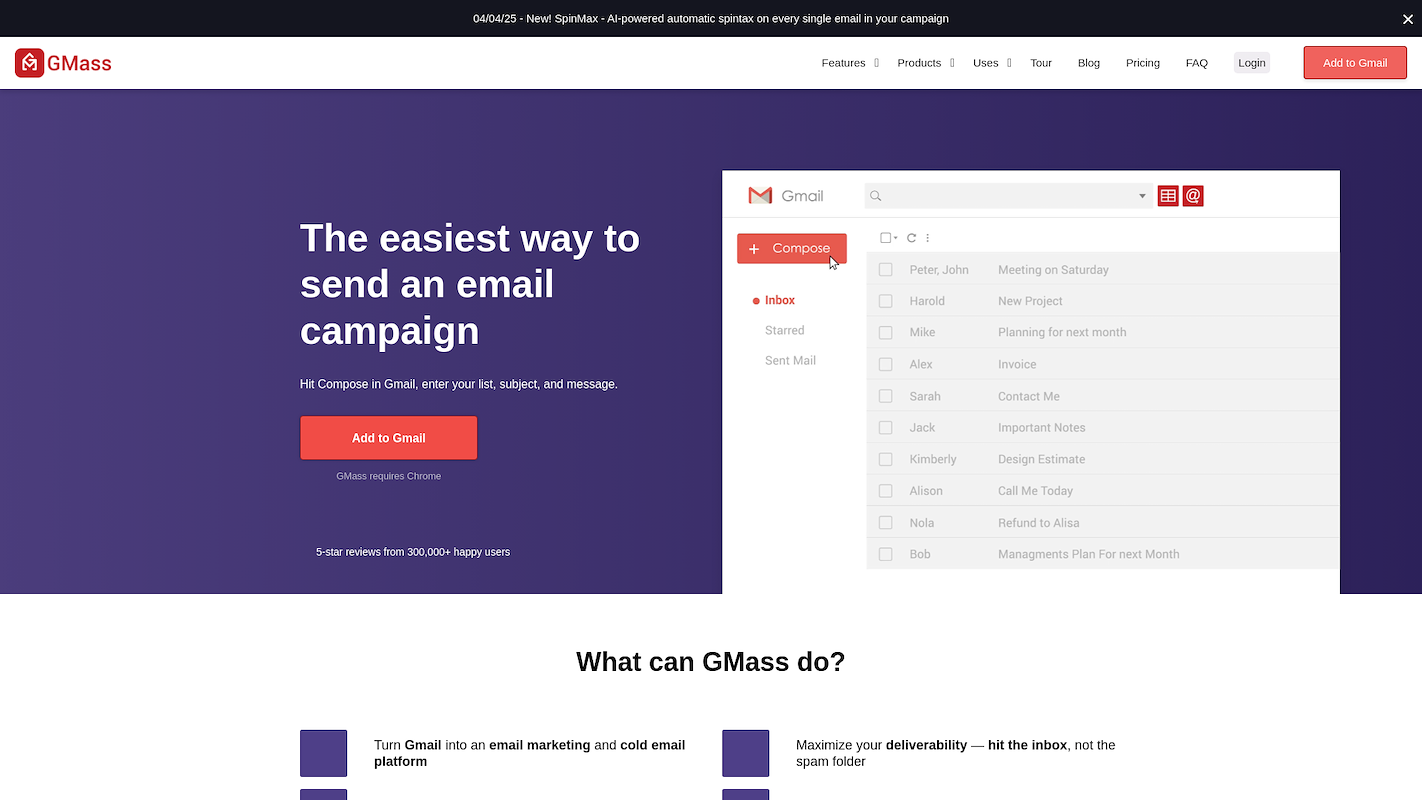
GMass is an email marketing tool that works inside Gmail. It allows users to send email campaigns to prospects from their Google account and connects to Google Sheets for mail merge. The platform automates follow-up messages and provides campaign reports within the Gmail interface. It is for individuals, startups, and sales teams who need to manage outreach activities.
GMass's Main Features
- Uses proprietary distribution technology to allow campaigns to exceed Google’s native daily sending limits.
- Connects directly to Google Sheets for mail merges and monitors for new rows to send emails automatically.
- Provides a deliverability toolkit that includes a spam solver with AI suggestions, SPF checks, and an inbox placement tester.
- Includes an email list builder to scrape contact addresses from a user's existing Gmail conversations.
GMass's Advantages Compared to Yesware
Average Review score: 4.8/5 stars based on 1,206 G2 reviews.
- GMass uses proprietary distribution technology to send campaigns that exceed Google’s native daily limits. This capacity for larger outreach differs from Yesware, which operates within standard email client restrictions.
- The platform includes a deliverability toolkit with a spam solver and inbox placement tester. This offers pre-send optimization, a feature set different from Yesware's focus on post-delivery engagement analytics.
- The tool connects directly to Google Sheets for mail merges. It automatically sends emails when new rows appear, which creates a more dynamic list management workflow than what is typically available with Yesware.
- An email list builder scrapes contact addresses from a user's existing Gmail messages. This tool generates new contact lists, a function not found in Yesware, which operates on pre-existing lists.
GMass's Limitations Compared To Yesware
- GMass has limited template management compared to Yesware. Yesware provides more robust tools for teams to create, share, and analyze template performance, which helps maintain message consistency across a sales organization.
- The tool's CRM integration can be less direct than Yesware's. Yesware often provides a more native connection with major CRMs, which helps sales teams automatically log activities and keep data in sync with less manual effort.
- Its reporting features focus more on bulk campaign metrics. In contrast, Yesware offers more granular, real-time analytics on how individual recipients interact with an email, a detail often useful for sales teams tracking specific deals.
Pricing and Cost-Effectiveness
Yesware provides transparent pricing at $15, $35, and $65 per user monthly. GMass does not publish its pricing, so for the most accurate information, we recommend visiting GMass's official website.
8) Woodpecker.co
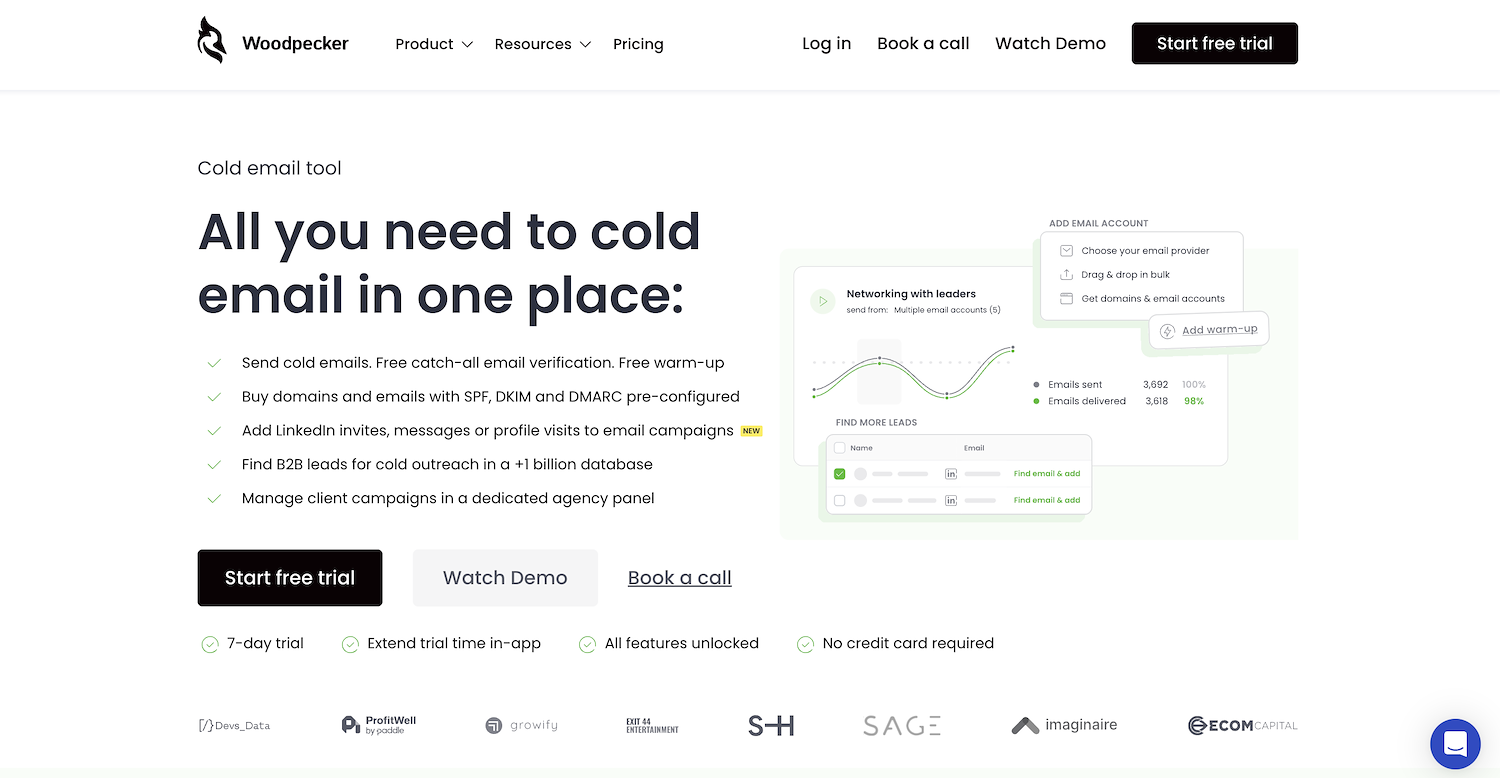
Woodpecker.co is a cold email tool for B2B companies, agencies, and recruiters. The platform automates outreach with personalized email sequences and follow-ups. It works with Gmail and Outlook accounts to help sales teams contact prospects from their inbox.
Use cases include sales development and lead generation. The tool also provides features for email deliverability to support campaign performance.
Woodpecker.co's Main Features
- Provides email verification to reduce bounces and an email warm-up feature to build domain reputation for deliverability.
- Includes inbox rotation, which allows users to send campaigns from multiple email accounts.
- Uses conditions to send different follow-up messages based on how a prospect engaged with the first email.
- Offers A/B testing for up to five different versions of an email to help determine which copy performs best.
Woodpecker.co's Advantages Compared to Yesware
Average Review score: 4.5/5 stars based on 93 G2 reviews.
- Woodpecker.co includes email verification and warm-up features to help build domain reputation. This differs from Yesware, which primarily tracks engagement after delivery.
- It offers inbox rotation, which lets users send campaigns from multiple email accounts. This allows for greater scale compared to Yesware's typical per-user pricing model.
- The tool uses conditions to send different follow-up messages based on prospect engagement. This provides more automated personalization than Yesware's standard follow-up capabilities.
- Users can A/B test up to five email versions to find the most effective copy. This provides a more robust testing framework than the standard template features found in Yesware.
Woodpecker.co’s Limitations Compared To Yesware
- Woodpecker.co operates from a separate dashboard, which is different from Yesware's direct integration into the email inbox. Some users may find Yesware's workflow more convenient as it avoids the need to switch between applications.
- The tool's analytics focus more on overall campaign performance. In contrast, Yesware provides granular, real-time data on individual recipient actions, which can be more useful for sales teams that follow specific deals.
- Its template management system may be less collaborative for large teams. Yesware offers more robust features for an entire sales organization to share and analyze templates, which helps maintain message consistency.
Pricing and Cost-Effectiveness
Yesware offers plans starting at $15 per user monthly, while Woodpecker.co's pricing begins at $29 per month for contacting up to 500 prospects. This makes Yesware a more budget-friendly option for basic, per-user needs. In contrast, Woodpecker's model, which is not based on user seats, may be more cost-effective for teams focused on outreach volume.
9) Klenty

Klenty is a sales engagement platform that helps sales teams execute outreach. Users can send personalized emails and automate follow-ups. The platform integrates with CRMs to sync data and sales activities, which helps teams build a sales pipeline.
The tool is for outbound sales, lead follow-up, and account-based sales. Sales teams use it to book more appointments and manage prospects with multi-channel communication.
Klenty's Main Features
- Integrates with CRMs like Salesforce, Pipedrive, and Hubspot to execute custom sales workflows.
- Includes task management to help sales teams organize and execute high-value actions.
- Provides analytics on workflow performance to ensure the repeatability and reportability of sales processes.
Klenty's Advantages Compared to Yesware
Average Review score: 4.6/5 stars based on 387 G2 reviews.
- Klenty offers deep CRM integration to run custom sales workflows. This allows for more complex automation based on CRM data, compared to Yesware's focus on activity logs.
- It includes a task management system to help sales teams organize high-value actions. This provides a structured to-do list within the platform, a feature not central to Yesware's email-focused toolset.
- The tool provides analytics on workflow performance to ensure sales processes are repeatable. This offers a higher-level view of process effectiveness, while Yesware's analytics center on individual email engagement metrics.
- This platform supports multi-channel cadences that include LinkedIn actions. This expands outreach beyond email, which is the primary focus of Yesware's engagement tools.
Klenty’s Limitations Compared To Yesware
- Klenty operates as a separate platform, which requires users to switch contexts. In comparison, Yesware integrates directly into Gmail and Outlook, so teams can manage tasks without leaving their email client.
- The tool's reporting focuses on overall campaign metrics. In contrast, Yesware provides granular, real-time data on individual recipient actions like opens and clicks. This detail is useful for sales teams that track specific deals.
- Some users find Klenty has a steeper learning curve due to its range of features. Yesware, with its focus on core email functions inside the inbox, often provides a more straightforward experience that teams can adopt quickly.
- Its template management system can be less collaborative for larger teams. Yesware offers more robust features to share and analyze templates across an entire sales organization. This helps maintain message consistency.
Pricing and Cost-Effectiveness
Yesware’s pricing tiers are set at $15, $35, and $65 per user monthly. In comparison, Klenty’s plans start at $50 per user for its Startup tier and go up to $100 for its Pro plan. This makes Yesware a more cost-effective choice for core email engagement, while Klenty's higher price point reflects its broader set of workflow automation features.
10) Reply.io
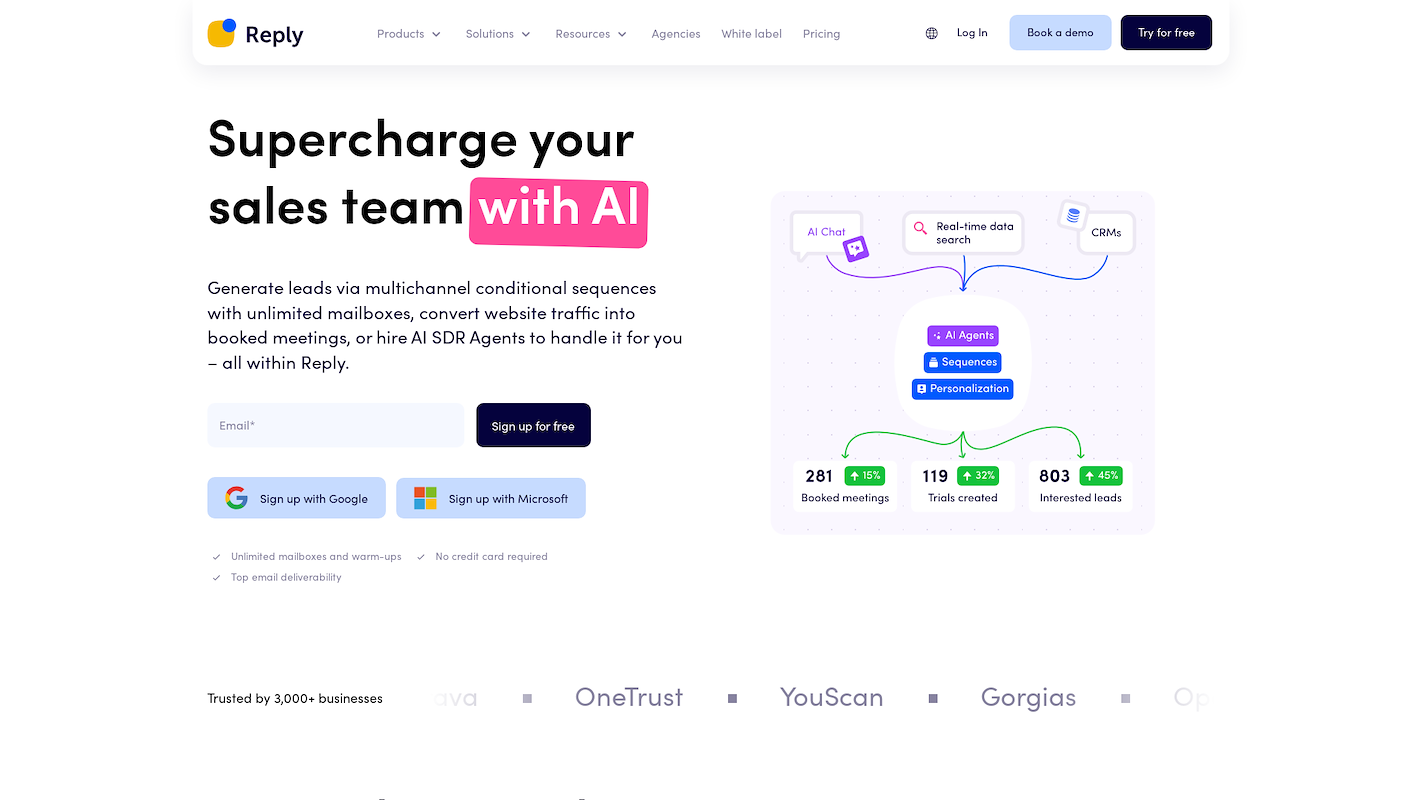
Reply.io is a sales engagement platform that uses AI to automate communication. Sales teams use it to find prospects and engage them across email, LinkedIn, calls, and SMS. The platform helps users generate leads and book appointments through multi-channel sequences.
Its main applications are outbound sales, account-based marketing, and business development. The tool also includes a B2B contact database for users to build prospect lists.
Reply.io's Main Features
- Deploys AI SDR agents to automate sales outreach, from finding prospects to handling responses.
- Includes a sales-trained AI chat with video avatars to engage website visitors and book meetings.
- Provides an email deliverability suite that monitors email health and offers email warm-up services.
- Combines email, LinkedIn, WhatsApp, SMS, and calls into dynamic, conditional outreach sequences.
Reply.io's Advantages Compared to Yesware
Average Review score: 4.6/5 stars based on 1,458 G2 reviews.
- Reply.io deploys AI SDR agents to automate sales outreach, from finding prospects to handling responses. This is different from Yesware, which provides email engagement tools for sales representatives to use manually.
- It supports multi-channel outreach that includes email, LinkedIn, WhatsApp, and SMS. This provides more communication options compared to Yesware's primary focus on email.
- The platform includes a sales-trained AI chat with video avatars to engage website visitors. This is a lead capture tool not found in Yesware's feature set.
- This tool offers an email deliverability suite with email health monitoring and warm-up services. This provides pre-send optimization, while Yesware centers on post-delivery engagement analytics.
Reply.io's Limitations Compared to Yesware
- Reply.io operates as a separate platform, which requires users to switch applications. In comparison, Yesware integrates directly into the email inbox, which some teams find more convenient for their daily workflow.
- The tool's extensive features can create a steeper learning curve for new users. Yesware, with its focus on core email functions, often provides a more straightforward experience that teams can adopt quickly.
- Some users report that its analytics focus more on overall campaign performance. This is different from Yesware, which provides detailed, real-time data on individual recipient actions, a detail often useful for sales teams who track specific deals.
Pricing and Cost-Effectiveness
Yesware offers paid plans at $15, $35, and $65 per user monthly. Reply.io provides a free plan, with paid tiers starting at $49 per user for email and $89 for multichannel outreach. Yesware is more cost-effective for core email engagement, while Reply.io's higher cost reflects its broader feature set, including AI automation and multi-channel capabilities.
Which One Should You Go With?
The right Yesware alternative depends on your team's specific needs, budget, and workflow. This guide provided a breakdown of several options to help you evaluate which tool best fits your requirements.
If you are looking for a different approach, 11x provides digital workers to manage sales tasks like prospecting, outreach, and lead qualification. This can automate parts of your sales process and consolidate your GTM stack, replacing multiple point solutions.


